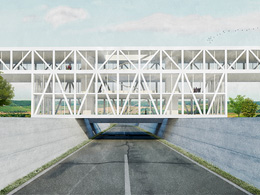STUDENTS PROJECTS
PROJECTS2015
Student : Tzemou Konstantina
Supervising professor: Panos Dragonas
University of Patras - Department of Architecture
Presentation date: November 5th 2015
Big metropolises of the 21st century face a big challenge: dense urban centers surrounded by diffuse periphery. Paris, serving as a vivid example of this metropolitan battlefield, is studied in this design thesis with particular emphasis on the backbone of the metropolis, the landscape along the infrastructure of mobility and its key role towards a linear model of metropolitan expansion.

Big metropolises of the 21st century face a big challenge: dense urban centers surrounded by weak and diffuse periphery. Paris can serve as a vivid illustration of this metropolitan battlefield. Apart from the vast lands of periphery and the compact center though, there exists the backbone of the metropolis, that being no other than the landscape along the infrastructure of mobility. These are the corridors that go through the whole gradient of different metropolitan densities, from the very center to the outer suburbs, connecting not only cities but also countries between them. This design thesis examines the wastelands along the northern Parisian transportation infrastructure, called terrain vague and attempts to bring to the foreground the already existing special dimensions of mobility, flows and lifecycles.
To do so, the method used lies upon three interconnected perimeters; the observation perimeter, where data are provided after site visits and on-site survey; the operation perimeter, where the overall strategy is proposed in multiple planning stages and lastly, the in-depth perimeter where three strategically chosen sites are examined in urban scale. These are the sites where the three, concentric, biggest orbital expressways of the Parisian metropolis intersect with the railway infrastructure.
In the first phase densification of the existing urban tissue is primarily attempted. A well-defined park is introduced along the infrastructure, so that the unsettled space of the edge be converted to an urban respite. Once the wasteland is reclaimed, the need arises to construct the urban façade. A built corridor frames the city and in the same time connects the fragmented urban tissue. Facilities of ephemeral life cycle are then hosted inside, enriching the metropolitan lifestyle always in relation to flows of people and goods.
All in all, recognizing that Terrain vague, not just in Paris but in every metropolis, stands between city and infrastructure and is therefore characterized by great geopolitical importance, the proposal promotes its economic prosperity and cultural diversity while simultaneously protecting its identity as the expanding limit of the designed environment.


















